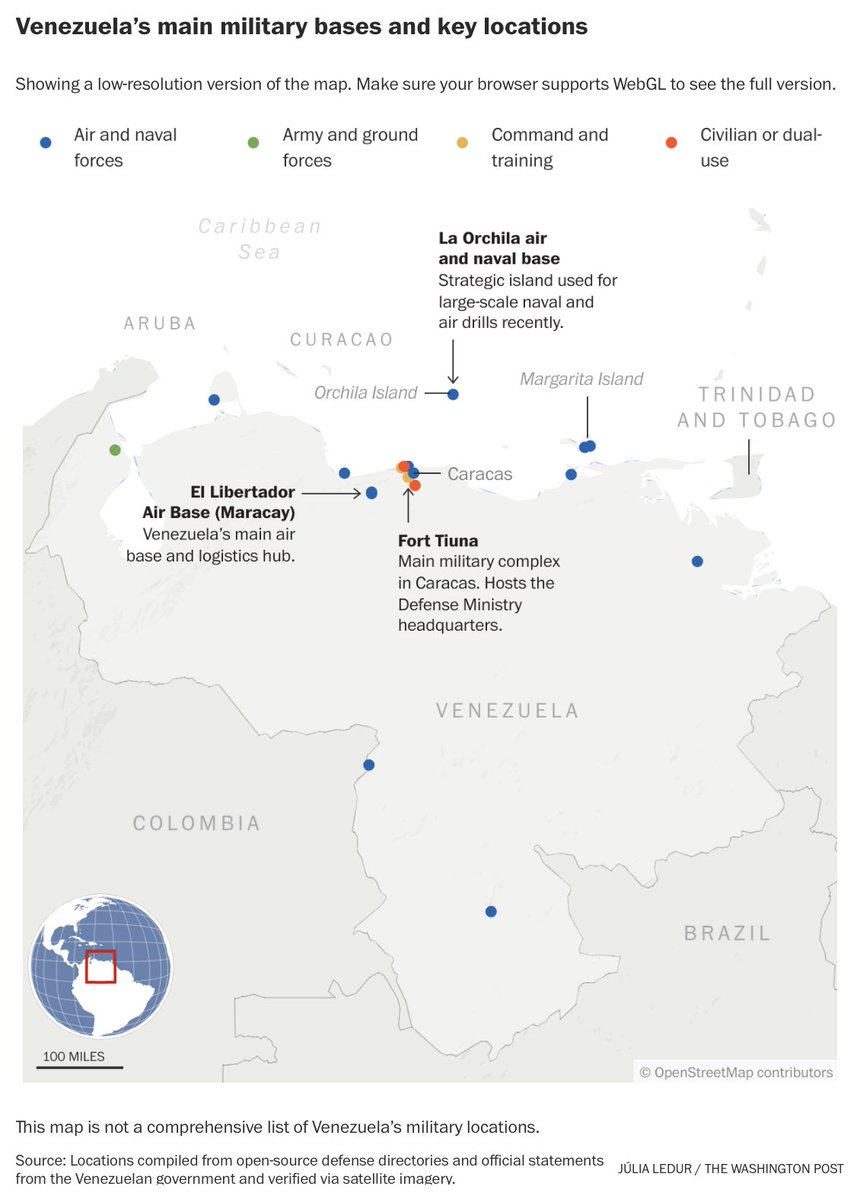This ad-free page was gifted by @salRides
Mapping potential military targets in Venezuela
Yesterday, the U.S. announced Operation Southern Spear to "remove narco-terrorists from our hemisphere." With the Ford carrier strike group now on station in SOUTHCOM, the U.S. could launch land strikes at any time.
w/ @SA_Defensa
Yesterday, the U.S. announced Operation Southern Spear to "remove narco-terrorists from our hemisphere." With the Ford carrier strike group now on station in SOUTHCOM, the U.S. could launch land strikes at any time.
w/ @SA_Defensa

"Defense Secretary Pete Hegseth and Joint Chiefs Chairman Gen. Dan Caine returned to the White House on Friday for a second consecutive day of deliberations centered on potential military action in Venezuela, as U.S. forces in the region prepared for possible attack orders.
It remains unclear if President Donald Trump has decided to pursue such an escalation, though high-level discussions over whether to strike Venezuela — and how — have been underway for days...
An administration official said 'a host of options' have been presented to the president." (WaPo)
It remains unclear if President Donald Trump has decided to pursue such an escalation, though high-level discussions over whether to strike Venezuela — and how — have been underway for days...
An administration official said 'a host of options' have been presented to the president." (WaPo)
https://x.com/ianellisjones/status/1989441781285433461
Special thanks to @SA_Defensa, he’s one of the best in the business.
https://twitter.com/sa_defensa/status/1989100569051689436
We were able to add detailed radar and ISR targets thanks to the excellent OSINT work by @gris_area. He geolocated the main CODAI (Comando de Defensa Aeroespacial Integral) radar surveillance network, as well as other rotational and temporary radar sites. Scroll his timeline for a deep dive.
"Fighter pilots aboard the USS Gerald R. Ford, an aircraft carrier that’s been dispatched to the region, have been studying Venezuelan air defenses, though they did not yet know whether they’ll be ordered to attack," WaPo reported.
If you want to read up on Venezuela's AD capabilities, I suggest this recent primer by @thewarzonewire:
If you want to read up on Venezuela's AD capabilities, I suggest this recent primer by @thewarzonewire:
"I sort of have made up my mind" about the administration's next steps in Venezuela, POTUS told CBS News aboard Air Force One, but "I can't tell you what it would be."
via @JenniferJJacobs @JimLaPorta
via @JenniferJJacobs @JimLaPorta
https://twitter.com/jimlaporta/status/1989513166074581317
WaPo: “Look for precision kinetic strikes against narcotics targets and military capability and, if that doesn’t have the desired effect, against leadership,” Jim Stavridis, a retired U.S. admiral, said. “I think the game here is to convince Maduro that his days are numbered, but convincing him of that will take a fair amount of strikes against Venezuela’s infrastructure.”
In the face of such force, Maduro might hunker down, Stavridis said. That would leave the Trump administration to potentially deliberate whether to carry out strikes against Maduro’s security or a Special Operations mission to capture or kill the authoritarian leader. Such an effort, Stavridis said, “would be pretty high-stakes, with a lot of potential risk.”
Stavridis suggested the United States could begin with strikes on airports or seaports that it identifies as potential shipping hubs for drugs. It also could strike shipment points near Venezuela’s border with Colombia, where significant quantities of cocaine originate. But the Pentagon also would want to attack Venezuelan air defenses to keep its own aircraft safe, the retired admiral said."
Graphic/source: @juledurg @DanLamothe @washingtonpost
In the face of such force, Maduro might hunker down, Stavridis said. That would leave the Trump administration to potentially deliberate whether to carry out strikes against Maduro’s security or a Special Operations mission to capture or kill the authoritarian leader. Such an effort, Stavridis said, “would be pretty high-stakes, with a lot of potential risk.”
Stavridis suggested the United States could begin with strikes on airports or seaports that it identifies as potential shipping hubs for drugs. It also could strike shipment points near Venezuela’s border with Colombia, where significant quantities of cocaine originate. But the Pentagon also would want to attack Venezuelan air defenses to keep its own aircraft safe, the retired admiral said."
Graphic/source: @juledurg @DanLamothe @washingtonpost

• • •
Missing some Tweet in this thread? You can try to
force a refresh













